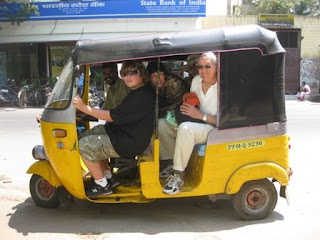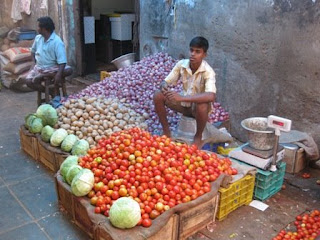March 9, 2009
This entry is a composite of photos and description from Reg and Georgia.
India was HOT, humid, VERY dirty, unsanitary, colorful, fascinating, mystical, and depressingly overpopulated and impoverished. The traffic was stunningly crowded with vehicles of every description. City traffic is mayhem - pedestrians; bicyclists; families of five on a motor scooter;

even larger families in three-wheeled tuk-tuks; a gaggle of people stacked atop a motorbike, at least one toting the obligatory goat, to list merely those conveyances with less than 4 wheels. What passes for expressways here have pedestrian crossings at regular intervals, all occupied by a minimum of two pedestrians. None of the pedestrian crossings are honored by the cows that wander wherever a cow might be going, a mystery in itself. We hired a car and driver to tour around southeastern India for several days. He drove these roads at high speed, with professional abandon, and frighteningly exhilarating confrontations with oncoming trucks, buses, tuk-tuks, goats, and cattle. He yielded only to the cattle. To harm a cow is a grave offense if you are a Hindu. Scaring the bejesus out of western passengers may be part of some devious religious conversion scheme he was pursuing; Georgia called out loudly to many gods, known and unknown, as we careened down the highways and byways. Whether her exhortations means that she's now a noviate in one of the many religions practiced here remains inscrutable. I do think she's given up vehicular traffic as a form of penance.
An additional note from Georgia- The horn is used as a form of eco location in India. You do not drive without one and it appears that there is very critical information transferred by the type of honk…none of which I am capable of translating. Applicable images would be threading the

needle or a game of chicken or the football terminology used when an offensive player is running with the ball and he is trying to squeak through the hole in the defense. It would not be possible for a non-Indian to rent a car and drive themselves around.
Here is a view from my position in the center back seat watching our driver find a hole in the traffic in front of us. That is Ganesh on the dashboard, the god of wisdom and travel. Maybe it was his presence that kept us safe. The bus by the way may be in the lane for oncoming traffic. There were not hard and fast rules regarding traffic lanes.We arrived in India at about 0800 on Thursday, March 5, docking in Chennai, the fourth largest city in India. Chennai used to be called Madras; it is in the Indian state of Tamil Nadu, and the main language spoken here is Tamil. Chennai has over 8 million people. India itself has over 1.1 billion people speaking 16 different languages and living in an area only one-third the size of the U.S., so the first thing you notice is all the people. People are everywhere – on the streets, on the sidewalks, riding bicycles, riding in pedal-bike rickshaws, riding motorbikes, riding in auto rickshaws, which are three-wheeled motor scooters called tuk-tuks, cars, trucks, and buses – there are lots of buses. The most interesting transportation and the cheapest is the tuk-tuk – the yellow vehicles here:
 We decided to try the tuk tuk Indian style. Before I got out to take the photo, I had been sitting on Reggie's lap for our raucus ride around Pondicherry.
We decided to try the tuk tuk Indian style. Before I got out to take the photo, I had been sitting on Reggie's lap for our raucus ride around Pondicherry.We went on a tour of the area south of Chennai, going first to Kanchipuram, a Hindu holy city noted for all of its Hindu temples. Hindu temples tend to be very colorful, decorated with images of the many Hindu deities. Here is a photo of the Mylapore temple in Chennai:

From Kanchipuram, we drove towards the southeast Indian coast, stopping first in Vendanthalgal bird sanctuary, where we saw lots of painted storks and other birds. Painted storks come to Vendanthalgal in the winter to nest and then in the spring they migrate north, flying over the Himalayan mountains, the highest mountains in the world, to China. We met some Indian schoolchildren who were on a field trip to Vendanthalgal. They wear school uniforms; each school has a different-colored uniform. The girls were laughing at the boys, and the boys were laughing at us because they seldom see people from the U.S. in Vendanthalgal. Here is a photo of them:

The boys thought themselves quite funny because they pointed to the girls and said "The stupids"....a universal boy thing.From Vendanthalgal we drove to Pondicherry, a seaside city. Pondicherry was the place where the French East India Company had their colonial outpost in India 200 years ago. There are still many people speaking French in Pondicherry; it did not become part of India until 1954. We visited another Hindu temple there. It was a temple dedicated to the Hindu god Ganesh. Ganesh is the god of knowledge and travel, so I was interested in seeing a temple for Ganesh. Ganesh has the body of a human and the head of an elephant. When he wants to travel, he rides on a rat.
The temple had an elephant that would bless you if you gave it a coin. You just stand before the elephant and when he sticks out his trunk, you drop a coin in it, and then he taps you on the head to bless you.
Jackson is being blessed by the temple elephant. 
Pondicherry also had a botanical garden, with monkeys running around. Here is a picture of Jackson in the foreground and a rhesus monkey in the background:
Rhesus monkeys are used as experimental animals in U.S. research laboratories because they are so similar to humans. We also saw ‘flying foxes’ in the botanical garden. “Flying foxes” are the largest bats in India; they have a wingspan of over 3 feet. Fortunately, they are fruit-eating bats, not vampire bats!
 The black things dangling among the branches are fruit bats.
The black things dangling among the branches are fruit bats. Although the people in India are very, very poor, the country is rich in cultural heritage. Three major religions began here in India – Hinduism, Buddhism, and Jainism, and there are also many Muslims here. St. Thomas, one of the 12 Apostles, came 2,000 years ago as a missionary to India and was martyred here. He is buried in Chennai. Over 16 different languages are spoken in India.
Everywhere you look you see color, intense color, exuberant colors that look like they radiate from the inside out. The people like brightly colored clothes, and the women wear saris of beautiful silk. It is not uncommon to see women working on construction sites in their saris. Houses might be painted in multiple colors and they might have straw roofs. Color is so revered

in India, they even have a festival of the colors called Holi. During this festival they throw colored powders on each other.
Inspite of the festivals, the colors and the endlessly fascinating culture, India is extremely poor and we saw evidence of devastating and debilitating poverty everywhere we went. The government considers anyone earning more than 50 rupees a day(one dollar) above the poverty line. And yet for the most part, the poor people press on finding the most efficient methods of survival available. For many of them it is sorting through trash for recyclables, selling handicrafts or simply stealing. We found joy, smiling faces, and laughter in the midst of desperate circumstances. Most Indians were friendly and curious towards us and of course asked about Obama and America. More than anything India was a humbling and at the same time enigmatic experience.
Today we are anchored and bunkering off of Singapore in the Philip Channel. We are surrounded by lush green islands, anchored ships and can see lots of oil refineries off in the distance. Singapore is the wealthiest city-state in the world and with 4.5 million people.
More photos of India below.

 Some students from the University of Pondicherry. One of them studies Biochemistry. We met them in the Botanical Gardens.
Some students from the University of Pondicherry. One of them studies Biochemistry. We met them in the Botanical Gardens.
Colored beads at the market.
 Georgia buying a dress for Bella in the market place.
Georgia buying a dress for Bella in the market place.
Boy selling tomatoes at the market. His father really wanted me to take his photo.

 Thailand is a jewel of a country. ….beautiful gold leaf temples and tropical beaches. I had a massage under the palm trees at a beach one day. It was heavenly.
Thailand is a jewel of a country. ….beautiful gold leaf temples and tropical beaches. I had a massage under the palm trees at a beach one day. It was heavenly.



























